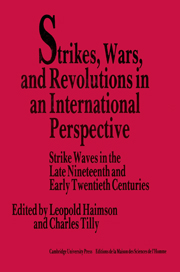 Strikes, Wars, and Revolutions in an International Perspective
Strikes, Wars, and Revolutions in an International Perspective 24 - Conclusion
Published online by Cambridge University Press: 25 March 2010
Summary
The contributions to this volume have repeatedly brought out, it seems to me, the impressions drawn in its introductory section concerning the similitudes that surfaced in patterns of labor unrest in the course of the major strike waves that unfolded in various countries of Western and Central Europe at the end and in the immediate aftermath of the First World War, and in Imperial Russia already by the eve of the war. Specifically, these contributions appear to confirm the view that what distinguished these strike waves from previous waves of labor unrest was the degree to which, at least among the strata of workers who were most militantly involved in them, all forms of labor unrest – including ostensibly economic strikes – came to focus explicitly over issues of power and authority. Even more notable was the acuteness of the sense that these strata of workers came to display of the inextricable link between their position in the workplace – and particularly the issue of control over the character and pace of their own work – and their position in the polity as a whole. It was the sense of this inextricable connection – so sharply demonstrated by the participants in these labor struggles even when they did not resort to the weapon of political strikes – that induced several of our contributors to assign to these waves of labor unrest a much more highly politicized character, and especially to detect in them more open, direct, if not generalized challenges of existing structures of authority, than had been the case of earlier strike waves in these countries' labor experience.
- Type
- Chapter
- Information
- Strikes, Wars, and Revolutions in an International PerspectiveStrike Waves in the Late Nineteenth and Early Twentieth Centuries, pp. 525 - 536Publisher: Cambridge University PressPrint publication year: 1989
- 1
- Cited by
